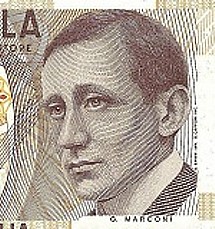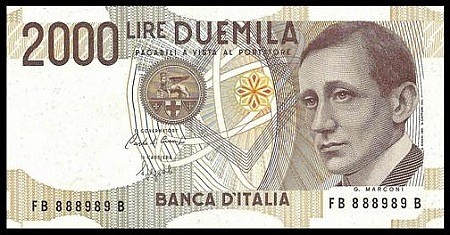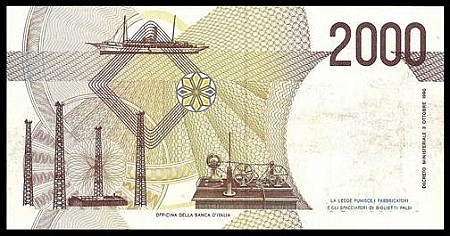ITALY
Guglielmo Marconi

When a new technology is produced, it is inevitable that it is created from the previous advances that were made. For example, the computer was created using wires and circuitry from the electronics field, and the results are displayed on a monitor that was developed from the cathode ray tube. There would be nothing like a modern computer without the previous technology which was fitted together in a manner that made it possible.
So too was the telegraph. It was a novel idea at the time, sending messages instantly from one place to another over a wire instead of by messenger or letter. It enhanced the world and communication was soon to bring the world closer to everyone. Sending messages quickly over large distances was not a new idea, but before the telegraph, it was limited to a man with a quick horse, or a series of bonfires, smoke signals, etc. These messages had obvious limitations in text and meaning, and they were far from instant.
In 1792 Claude Chappe invented the semaphore telegraph and which used sliding panels or long beams with arms held at angles to indicate individual letters and words. This was in essence a telegraph, but it required a line of sight to decipher. It overcame the textual limitations of the bonfires and smoke signals, but not much else. Then in 1837 there was a leap in technological advancement. Using electricity, one could transmit a series of signals that could travel over a wire and these signals could be interpreted. While the limitation was that there was a need for a wire connecting the two stations, the distances that could be covered were vast and no line of sight was required. Day or night, snow, rain or sunshine, it didn’t matter. Your message could get from one location to another instantly. Thomas Morse is credited with being the father of the American Telegraph. Though others in the United States had telegraphic systems, his was the first commercially successful electric telegraph in the states. In England this honor goes to Sir William F. Cooke who also patented his system in 1837. In 1845 this system was used to arrest John Tawell for the murder of a young woman in Berkshire, England. While Tawell was on a train fleeing to London, the Berkshire authorities telegraphed a message to London which directed police to the correct platform to arrest John Tawell, who was later hanged. This incident demonstrated the efficiency of the telegraph and made it more popular.
But as time and technology marched on, newer advances were made. In the 1880’s the German physicist Heinrich Hertz experimented with what were to be called Hertzian Waves, which are electromagnetic waves created from oscillating current. He discovered that these could travel over small distances when he detected them using an antenna hooked up to a cylinder of metal filings which would become energized. Hertz went to his grave assured that electrical waves were of no significance; and so it was until Guglielmo Marconi picked up where he left off.
Marconi was born in Bologna Italy on April 25, 1874 to a wealthy Italian farmer Giuseppe Marconi. His mother was Anne Jameson, an Irish protestant whose family owned the famous Jameson Irish Whisky distillery. He grew up rich and wanted for nothing, but that alone didn’t ensure his success. His mother did not want him being taught by the Catholic schools in Italy, so until he was 12, he was schooled entirely at home, where his English was much better than his Italian. But learning only from home also made him deficient not only in his countries language, but also in his social abilities. He had trouble making friends and always tried to adopt a superior attitude to mask his nervousness. This trait stayed with him his whole life, and people would remark that he seemed too old for such young man.
The field of electricity was a very popular subject the world over when Marconi was a young man, and as a young man he was fascinated by the subject. It helped that he was living in Bologna, for several historic experiments in electricity were made there. Luigi Galvani had experimented with electrical charges in dissected frogs, making there dead limbs move. Alessandro Volta created the electric battery to supply a constant current. This was undoubtedly known to Marconi as his mother ensured that he continued tutoring in his favorite subject, electricity. He eventually found a tutor named Nello Marchetti who was a retired telegrapher. Marchetti taught Marconi morse code and how to send messages via the telegraph. His tutors explained electrical theory and public awareness of electricity and how it can travel; even over short distances such as Hertz had shown were all common knowledge. But it took Marconi to come up with the idea to create Wireless Telegraphy.
Marconi was consumed by his idea. It was his sole passion. He toiled in his makeshift laboratory on his father’s land building his telegraphy apparatus and experimenting with different coils, types of conductors, wavelengths, etc. The fact that he wasn’t a scientist likely increased his need to experiment over and over again with failed systems. Yet his perseverance saw him through and he eventually happened upon the right sized receiver with just the right mix of metals in the cylinder to receive his broadcast signal. Once he was able to rig his device to ring a bell when it sensed the electrical signal, he started moving the distance farther, out of the laboratory.
One of his final experiments on his father’s farm tested the signals ability to be read over out of direct line of sight – which is something the scientists of the day scoffed at. They believed that any signal traveled in a straight line only and would be blocked by anything in its way. More experiments and tweaking of his wireless telegraph were made, and soon he built a large antenna and increased his signals output. He sent two helpers out and when they were on the other side of a large hill, he sent the signal. Immediately he heard a gunshot – his helpers signal that they received his transmission. Marconi then felt ready to show it to the world; He booked passage on a ship to London, where his patents were sure to be held more securely.
His arrival in London was not as he had hoped. His equipment was seized when he went through customs and subsequently destroyed. With the help of a cousin who was living there, Marconi frantically rebuilt an apparatus and sought a meeting with the British Postal Office, which at the time was in sole control of all telegraphic transmissions within Great Britain. His cousin was able to introduce him to the highest ranking person there, William Preece, the chief electrician who had experimented with Hertzian waves before, but had very limited success. Preece was amazed with Marconi’s new machine and with the distances he was able to achieve with it, and thought that Marconi was on the right path. He offered Marconi the whole of the British Postal Office at his disposal for any further tests to continue to improve his telegraph before placing it into production. Marconi felt certain that the post office would purchase his invention.
Marconi was soon giving exhibitions to the Navy, the Army, the royal family, and even the Royal Institute. He was very careful not to disclose the inner workings of his device as he felt certain that others would use it against him and file the patent before he could. Marconi suffered lashback from the scientific community for his secrecy, and they labeled him a fraud. But Marconi held fast and kept his secrets hidden in their box. Marconi used the Postal Offices personnel and equipment to his advantage, and eventually was able to establish communication from shore to ships at distances not even dreamed of before. But his patience with the postal office was wearing thin. They were not coming forth with an offer for his invention, and Marconi wasn’t able to compete with them as the law established the post office with all control of telegraphy in England. So in 1897 Marconi accepted an offer to form a company with investors linked to his mother’s side of the family and their distillery. This proved to be a very profitable venture, but one which would cost him his contacts with the post office.
Marconi was now rich. He had backing to create private telegraphy stations for experimenting, and he could even compete with the post office as long as he sent messages to his own stations. He was not allowed to send messages to the Post Office. Later in 1887 he received his patent, securing him as the first commercial wireless telegrapher in Europe. It still needed work, however, and over Marconi continued his experiments at increasing distance and reducing interference from the atmosphere and increasing its transmission range.
Marconi had a strong sense that he was always in a race to be the first to develop a marketable wireless telegraph system, and he was right. He had several others who were also experimenting with their own wireless systems as well, and some of them were very prominent. One such person was Sir Oliver Lodge, who was not only a famous physicist, but also, at a time when Spiritualism was in its heyday, well known as one of the first scientific paranormal researchers. Marconi had kept his apparatus in a box and would not show it to others because of his inherent mistrust that others would beat him to the finish line. This did not sit well with Lodge who, for all his open mindedness with the spiritual world, was always skeptical of Marconi’s claims. Lodge had the idea that wireless was limited in range and that interference from other wireless systems couldn’t be overcome. Even when Marconi demonstrated his abilities to overcome these issues, Lodge was still skeptical about Marconi’s claims and his hidden apparatus. Eventually he would adopt Marconi’s methods and start his own research into tuning signals and increasing the range, but never could catch up to Marconi’s lead. In addition to Lodge there were several other startups throughout Europe and the Americas, but one of the largest concerns Marconi had was the German Government, which, in hopes to make a business deal, was given one of Marconi’s sets in good faith. The Germans reverse engineered his work and started making their own wireless technology based on his systems. To maintain his lead, Marconi had to work at a furious, unrelenting pace, which would cost him in both business alliances and in his love life as well. Marconi would marry twice, but he would have several failed attempts, all due to his devotion to work.
Marconi was always certain of his abilities and his technology, despite the skeptical Lodge and other physicists had to say. While that leading scientists of the day were certain that the emanating waves from Marconi’s wireless (and all other waves for that matter) would go in an unwavering straight line and would not be able to go much beyond the horizon and certainly not from Europe to North America. But Marconi had his practical experiments of going through walls, and around large hills that made him think otherwise, even though he did not fully understand it all. So in 1901 Marconi traveled to Canada and the USA and set up stations there and made attempts to communicate to Europe. His efforts were slow because of his limited understanding of the propagation of radio waves. Large arrays of antennas were constructed with miles of wire. Large electrical generator was used to create the energy that Marconi and his engineers calculated was needed to transmit across the ocean. While he was able to eventually receive faint signals, he could not reproduce his experiments at will. In fact, Marconi could only transmit these long distances at night. Knowledge of transmission was still in its infancy, and it would be a few years before Marconi would be able to overcome this serious limitation.
Marconi nonetheless enjoyed success. His continued efforts ensured that ships could contact each other in the middle of the ocean, could come in contact with the shore long distances at night and still communicate hundreds of miles away during the daytime. Ships could radio for emergencies and other important messages. One such message came to Marconi himself. He had married Beatrice O’Brien in 1905, but the marriage was a lonely one for poor Beatrice. Marconi’s devotion to work took precedence over everything, even his family life. So in 1910, even though his wife was due soon to give birth to their first child, Marconi set sail on a ship to travel for more of his experiments. While at sea, Beatrice sent word by wireless to Marconi that he now had a son. But to cement the case for Marconi’s wireless to be accepted by not only the public, scientific and commercial communities across the world history would again repeat itself.
In 1845 wired telegraphy was used to capture a murderer who thought he had escaped by train. In 1910 wireless telegraphy was used to catch a murderer who thought he’d escaped the clutches of the law by sailing away on a ship.
Hawley Crippen had murdered his wife and fled with his innocent mistress who thought his wife died while abroad. A manhunt ensued and a strong lead was sent to Scotland Yard from the captain of the Montrose, a ship headed to Montreal, Canada. In short order, a detective was sent on another, faster ship. As luck would have it, he would arrive a day before Hawley Crippen and his mistress. The captain of the Montrose maintained communication with authorities and as there was still some bleed-through from the signals, the whole world was soon enthralled with the first ever high seas chase transmitted via wireless telegraphy. As the days passed, the captains transmissions of the couple’s daily habits and their relaxed attitude of being certain of escape provided what was then a strange portal into the lives of the unsuspecting suspects. Meanwhile, plans were transmitted to capture the duo when they arrived in Canada. The detective arrived, and disguised as a Canadian official, boarded the ship and made contact with Hawley Crippen and arrested him on the spot without incident. Not only could ships convey their messages to each other and to shore, but criminals could now be tracked and caught with relative ease. Marconi’s device was now more famous than ever.
Two years later, Marconi and his wife Beatrice booked passage on the Tatanic’s maiden voyage. Marconi however left on an earlier ship, leaving his wife to travel alone on the Titanic. Yet the night before, their son became ill and she cancelled her trip. While crossing the northern Atlantic, it struck an errant iceberg and sank. With over 2,200 passengers and crew, over 1500 died. That any survived at all was a testament to the wireless operator who signaled an SOS and their location, which was received by the Carpathia who arrived and picked up those too few survivors.
In 1923 Marconi divorced Beatrice and left her with his son and two daughters. He would later married a woman named Maria Bezi Scali. Benito Mussolini was Marconi’s best man.
Later on in 1931 Marconi would realize through experimentation that he had followed (and other’s followed his lead) the wrong assumption that longer radio waves would travel further. In fact, it was shorter radio waves that were found to travel further and with much less electrical energy. These radio waves were strong enough to counter the effects of the sun on the Ionosphere which reduced interference greatly and allowed daylight transmission to overcome the needed distance requirements.
Guglielmo Marconi died on July 19, 1937 of a heart attack. For two minutes, wireless operations stopped in his honor.
Marconi’s telegraphy opened the way for instant worldwide communication that not only allowed ships to be safer at sea, but would allow people all over the world to send messages to far flung places, and in essence, bring the people of the world closer together. Ever the communication visionary, Marconi, towards the end of his life had even set up a station to listen for signals from outer space. A similar program is now carried on to this day by the SETI (Search for Extra Terrestrial Intelligence) Institute.

